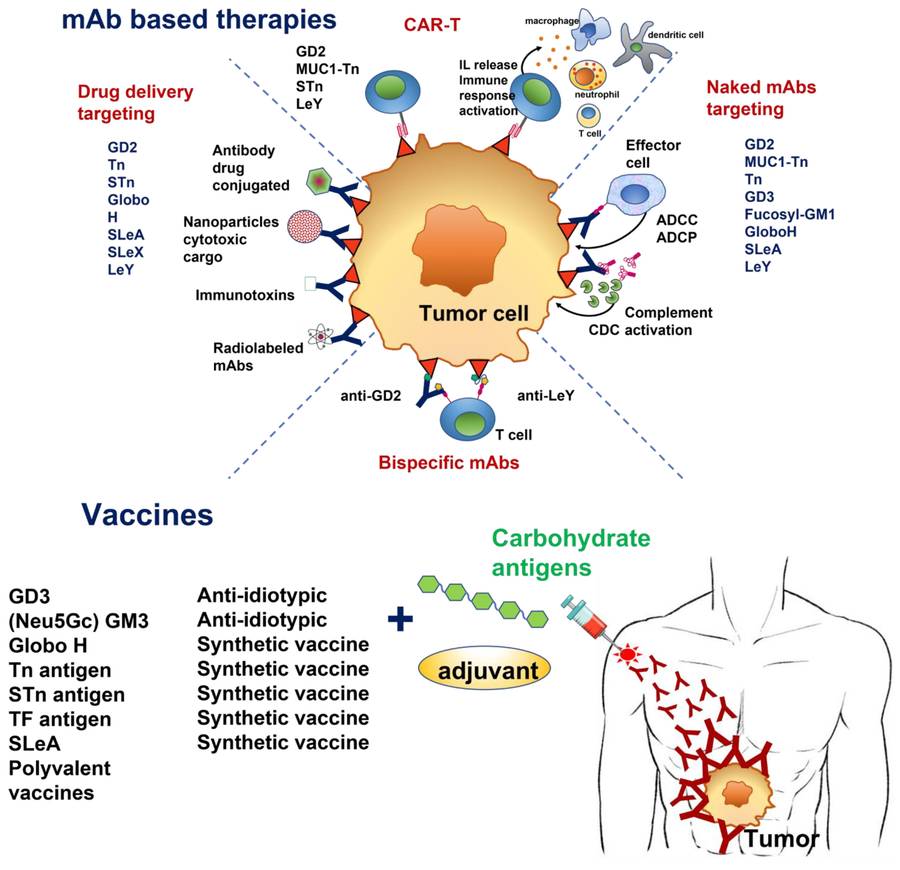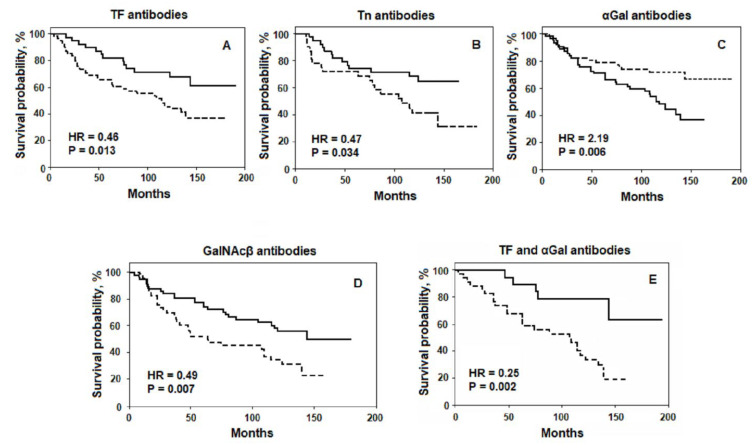Anti-Glycan Antibody in Cell-Surface Glycoconjugate Characterization
Introduction
The glycoconjugates constitute fundamental elements of the cell surface carbohydrate layer across diverse cellular systems. These biomolecules mediate critical biological processes such as osmotic balance, intercellular recognition, hormone receptor interactions, phagocytic evasion, desiccation resistance, cellular differentiation processes, immune defense mechanisms, and ionic flux regulation. Analyzing the biochemical composition, three-dimensional architecture, and localization of these membrane associated sugar-protein/lipid complexes frequently employs glycan-targeting immunoglobulin probe. Creative Biolabs delineates innovative methodologies leveraging glycoepitope specific antibodies for comprehensive surface glycomolecule profiling, emphasizing their analytical precision and multiplexed detection capabilities.
 Fig.1 Schematic representation of antitumor strategies based in antibodies and vaccines targeting TACAs (Tumor Associated Carbohydrate Antigens).1,2
Fig.1 Schematic representation of antitumor strategies based in antibodies and vaccines targeting TACAs (Tumor Associated Carbohydrate Antigens).1,2
Strategies for Profiling Cell Surface Glycoconjugates Using Glycan-Specific Antibodies
- Immunohistochemical Localization
Tissue specimens undergo fixation and preservation for histological analysis. Antibody incubation is performed on processed sections, followed by detection using enzyme-linked or fluorophore-conjugated secondary reagents. This method uniquely resolves glycans' topographical distribution, subcellular compartmentalization (intracellular vs. extracellular), and expression gradients across tissue architectures, features unobtainable through bulk analytical techniques.
- Flow Cytometric Quantification and Fluorescence-Activated Sorting
Cellular suspensions are exposed to glycan-targeting antibodies tagged with biotin or fluorochromes, enabling fluorescence activated quantification via hydrodynamic focusing systems. Signal intensity directly correlates with glycan density, allowing quantitative assessment of surface expression. Spatial resolution is further enhanced through correlative imaging modalities: confocal microscopy captures dynamic membrane microdomains, while transmission electron microscopy with lectin-gold labeling visualizes nanoscale glycan clustering.
Advantages of Anti-Glycan Antibodies in Cell-Surface Glycoconjugate Analysis
- Enables precise characterization of surface-exposed glycans under low cellular abundance conditions
- Facilitates detection of differentiation-stage-specific glycol epitopes and their dynamic expression patterns
- Allows detection of subtle inter-sample variations in protein glycosylation profiles
- Provides structural resolution for mapping native glycan topologies
Published Data
 Fig.2 The relation of the preoperative AG Abs level to the survival rate of patients with gastrointestinal cancer.2,3
Fig.2 The relation of the preoperative AG Abs level to the survival rate of patients with gastrointestinal cancer.2,3
The article highlights that abnormal glycan structures in cancer serve as promising biomarkers and therapeutic targets. While circulating auto-antibodies (auto-Abs) to Tumor-Associated Glycans (TAGs) might offer protection against cancer, their precise protective role and association with cancer progression remain largely unclear, indicating an area where further experimental data is needed. The experimental study of anti-glycan antibody (AG Ab) specificity faces challenges due to the inherent heterogeneity of natural glycans. To overcome this, the article emphasizes the utility of synthetic glycoconjugates with known structures as precise tools for studying glycan-binding proteins. Furthermore, glycan microarrays are presented as powerful bioinformatic tools, enabling the simultaneous detection of a large set of antibodies binding with various glycans. This methodological advancement is crucial for efficiently analyzing the complex interactions in this field. The research also underscores the significant connection between AG Abs and the gastrointestinal microbiota. While a healthy microbiota supports immune homeostasis, dysbiosis can contribute to inflammatory disorders and cancer, with bacterial microbiota either inhibiting or stimulating carcinogenesis through diverse mechanisms. The article, therefore, summarizes existing knowledge and points towards the need for more targeted experiments to fully elucidate the roles of AG Abs and microbiota in gastrointestinal cancer monitoring.
What We Can Offer?
Creative Biolabs offers a comprehensive suite of services centered around Anti-Glycan Antibody in Cell-Surface Glycoconjugate Characterization, designed to empower your glycomics research and development:
- Various High-Quality Anti-Glycan Antibody Products
- Quantitative Glycan Expression Profiling
- Identification of Unique Glycan Determinants
- Immuno-Phenotyping with Glycan Marker
- Custom Assay Development & Optimization
Experience the Creative Biolabs Advantage - Get a Quote Today
Why Choose Us?
Choosing Creative Biolabs for Anti-Glycan Antibody in Cell-Surface Glycoconjugate Characterization means leveraging over two decades of specialized expertise in glycomics and antibody technology. We are uniquely positioned to address the inherent challenges of glycan analysis, offering a robust and precise approach.
- Deep Glycomics Expertise: Our scientific team possesses extensive knowledge in glycobiology, ensuring accurate experimental design, meticulous execution, and insightful interpretation of complex glycan data.
- Extensive Antibody Library: Access to a vast and continuously expanding collection of highly characterized anti-glycan antibodies, allowing for precise targeting of diverse glycan families and epitopes.
- Advanced Instrumentation: Utilization of state-of-the-art flow cytometers, confocal microscopes, and high-resolution electron microscopes for unparalleled sensitivity and spatial resolution in glycan visualization.
- Customizable Solutions: Flexible service options tailored to your specific research needs, from broad screening to in-depth analysis of specific glycoconjugates, including the identification of minor differences in protein glycosylation.
- Comprehensive Data Delivery: Beyond raw data, we provide expertly analyzed and interpreted results, empowering you with actionable insights for your research and development projects.
FAQs
Here are some realistic questions potential customers often ask about Creative Biolabs' Anti-Glycan Antibody in Cell-Surface Glycoconjugate Characterization Service:
Q: What is the primary benefit of characterizing cell-surface glycoconjugates with anti-glycan antibodies?
A: The primary benefit lies in gaining highly specific insights into the "sugar code" on cell surfaces. This allows for precise identification of unique glycan determinants, their spatial arrangement, and changes in their expression during various cellular processes or disease states. This detailed characterization is crucial for understanding cell-cell interactions, immune recognition, and discovering novel biomarkers, especially useful when a limited number of cells are available.
Q: How does this service help in understanding disease progression or therapeutic efficacy?
A: Aberrant glycosylation is a hallmark of many diseases, including cancer. By characterizing these altered glycan patterns on cell surfaces, our service can identify disease-specific glycan biomarkers or changes in glycosylation profiles that correlate with disease progression or response to therapeutic interventions. This can inform diagnostic development, patient stratification, and lead to more targeted therapies, such as those targeting Tumor-Associated Carbohydrate Antigens (TACAs).
Q: What are the typical limitations or considerations when using anti-glycan antibodies for characterization?
A: While powerful, a primary consideration is the availability of highly specific anti-glycan antibodies that target different glycan families and epitopes. Glycan heterogeneity can also pose challenges. However, Creative Biolabs mitigates these by leveraging our extensive antibody library and expertise in assay optimization, ensuring the most accurate and reliable characterization possible. We also recommend discussing your specific research goals with our experts to ensure the most appropriate experimental design.
Related Products and Services
To further support your research and development in glycobiology, Creative Biolabs offers a suite of products:
- Monoclonal Antibodies
- Polyclonal Antibodies
- Secondary & Tag Antibodies
- Isotype & Loading Control Antibodies
- Carbohydrate Antigens
Creative Biolabs also provides related services, click the buttons to find more details.
Creative Biolabs offers a series of anti-glycan antibody-related services for worldwide customers. To explore these capabilities, please contact us for more information.
References:
- Puvirajesinghe, Tania M, and Jeremy E Turnbull. "Glycoarray Technologies: Deciphering Interactions from Proteins to Live Cell Responses." Microarrays (Basel, Switzerland) vol. 5,1 3. 4 Jan. 2016, DOI:10.3390/microarrays5010003
- Purohit, Sharad et al. "Multiplex glycan bead array for high throughput and high content analyses of glycan binding proteins." Nature communications vol. 9,1 258. 17 Jan. 2018, DOI:10.1038/s41467-017-02747-y
- Distributed under Open Access license CC BY 4.0, without modification.
